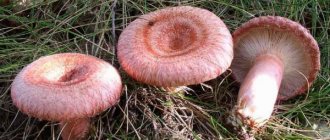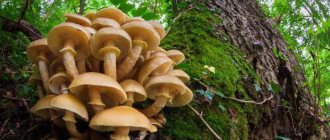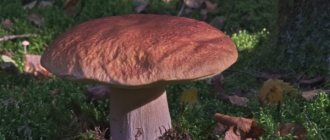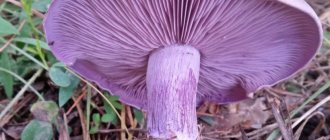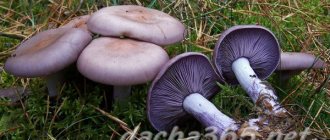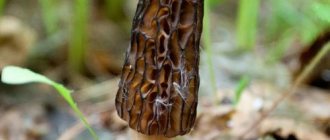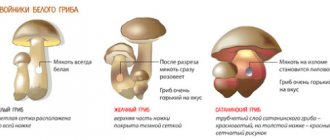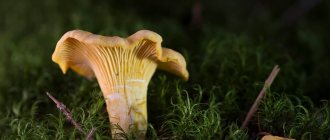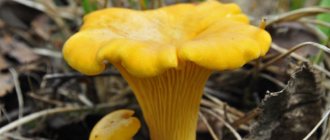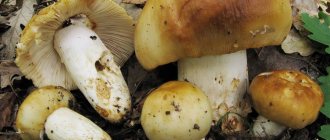Chanterelle mushroom photo and description which are discussed in this article, has tasty and aromatic pulp. Mushroom pickers also appreciate the fact that this species is not affected by insects or worms. This is possible thanks to chitinmannose, a substance that affects helminths and their eggs.
Chanterelles are collected by many lovers of “silent hunting” also because they grow in large groups. If you come across one or two mushrooms on the way, then you should look carefully; the rest of the representatives of this colony are most likely hidden under the moss or fallen leaves.
So, let's look at the appearance of this tasty and healthy mushroom, study their habitat and learn to distinguish representatives of different types of chanterelles.
What do chanterelle mushrooms look like?
Representatives of this species have one structural feature: the cap and leg are a single whole. There is no classic fit of the cap on the detachable stem. The color of the cap and legs is approximately the same: from light sunny to rich red or even orange.
The mushroom cap is flat and can reach 5-10 cm in diameter. It has curved and wavy edges. You can compare the shape to an umbrella that is turned inside out. The structure of the mushroom itself is dense and smooth; the skin is difficult to separate from the pulp.
The edible part of the mushroom is yellowish, sometimes with a white tint. The taste of the pulp is slightly sour, but some say there is a slight taste of dried fruit. The surface takes on a slight red tint if you press lightly on it.
The leg has the same shade as the cap. Sometimes it may be slightly lighter. Its length is 5-7 cm, and its thickness is up to 2 cm. The structure is smooth and dense, and the shape of the base is uniform, slightly narrowed downwards.
Habitats
You can meet chanterelles in different places. Like cockerels, they can grow in pine, spruce or deciduous forests. Most often, chanterelles are found in small-leaved and coniferous plantations with a sufficient amount of moss. They prefer to grow in the shade, but if the weather is not hot and rainy, then they feel great in open areas.
Like their counterparts of other species, chanterelles like to grow in groups. Moreover, their groups are numerous and appear en masse after thunderstorms. Mushrooms must be collected carefully, cutting them off so as not to damage the mycelium.
Important! Mushrooms that grow not far from the road cannot be used for food. Even if they look quite appetizing, such fruits will do more harm than good, because they tend to accumulate harmful substances and heavy metals.
Distribution area
White volnushka has become quite widespread in many regions of our country. As a rule, this fungus is characterized by the formation of mycorrhiza with birch trees, so most often Lactarius pubescens is found on the edges of birch groves. It grows somewhat less frequently in young coniferous and birch forests.
The mycelium forms a significant number of fruiting bodies, so Lactarius pubescens is characterized by growing in fairly large groups. Peak fruiting occurs in the last summer month and the first ten days of September. The main difference between the white milkweed and other white-colored milkweeds is the pubescence on the cap.
Beneficial features
Chanterelles are popular among mushroom lovers. But besides taste, they are valued for their beneficial properties. They contain a lot of carotene, which provides the bright color of the mushroom, and there are other useful substances.
Chanterelles contain more manganese than other mushrooms, about 1/5 of the daily requirement required by the body. There is also a high content of vitamins:
- RR ¼ of the daily value in the raw product;
- A – about 15%;
- beta-carotene – 17%.
Contains the following:
- trace elements: selenium, zinc, copper;
- macroelements: phosphorus, sulfur, calcium.
But there are some substances that make this mushroom special:
- Polysaccharide of chymomanosis. This substance has the property of destroying parasites and worms in the human body. Moreover, the substance is completely natural, so it does not cause side effects. Its action is selective and does not affect liver function. Moreover, not a single parasite can survive exposure to chymomanosis.
- The polysaccharide ergosterol, also known as provitamin D2, which cleanses the liver, including parasites that like to settle in it. The effect of this substance on enzymes helps improve liver function.
- Tramentolinic acid and K-10 polysaccharide, which are found in chanterelles, fight the hepatitis virus.
For those who limit the amount of calories they consume, chanterelles will be a godsend.
100 g of chanterelles contains:
- 19 kcal;
- 1.5 g proteins;
- 1 g each of fat and carbohydrates;
- 7 g dietary fiber.
These mushrooms are good for digestion and are quite appropriate in the diet of those who are on a diet. They contain 89% water, so during the cooking process they decrease in volume by 3-4 times.
Do I need to clean the rows and how to do it dry?
Some housewives may wonder whether it is necessary to clean row mushrooms at all? So, this is a very important process, because the quality of the final product will depend on it. In addition, all types of rows grow on the soil, preferring to settle on fallen leaves and pine needles, as well as on moss. Thus, contamination will definitely be present, which means cleaning will be necessary. The following methods will show you how to properly clean row mushrooms.
Sometimes a lot of debris collects on the fruiting body, then you can use the dry method. Some housewives prefer to freeze or dry rows, so in this case their contact with water should be minimized. Here it is best to resort to dry cleaning. To ensure that the taste of the prepared delicacy does not upset the consumer, it is necessary to take into account all the features of the preparatory stage. So, how to properly clean row mushrooms using the dry method?
To do this, we need to take an ordinary kitchen knife that will be comfortable to hold in your hand, a kitchen sponge or toothbrush, and vegetable oil. Using a knife, we remove all large contaminants on the fruiting body, and also pay attention to damaged areas. Such places need to be carefully cut off, capturing the “healthy” part of the mushroom.
Remember that the fruiting body is allowed for further use only if the affected area is no more than 20% of the total area of the mushroom.
In addition, you need to cut off the lower part of the leg, because it is usually very hard. Sometimes you can notice that the cap is damaged, but the stem is not, and vice versa. In this case, only the damaged part of the fruit body is removed, and the strong and intact part remains for further processing processes. In addition, do not forget to look under the cap, because a lot of microscopic debris collects in the plates.
How to properly clean the rows further using the mentioned equipment? We put the knife aside, and in the meantime, moisten a kitchen sponge or toothbrush in vegetable oil and wipe the surface of the mushroom. We pay special attention to areas with remains of stuck leaves, pine needles and other forest debris. If necessary, lightly rinse the mushrooms under the tap, and then proceed to further processing: boiling (required), freezing, pickling, etc.
Edible types of chanterelle mushrooms
Mushrooms have an unusual taste, which makes them very attractive to mushroom pickers. Although all mushrooms have common characteristics, there are different species of the same mushroom.
Ordinary (real)
- This species has become one of the most popular in its subgroup. This is an edible and healthy mushroom.
- It is usually the upper dome that grows and enlarges. Hats can be of different sizes, from 2 to 10 cm in diameter. Although it seems that the entire clearing is red in color, if you look closely, you can see that the shades vary, from light yellow to bright orange or rich red. The cap has a slightly sour taste.
- It is very difficult to separate the skin from the body. The edges of the pulp are yellow, a shade paler when cut.
- The stem is the same color as the cap. It reaches 4-7 cm in length and up to 3 cm in thickness.
Interestingly, parasites, worms or insects do not attack this fungus. This is possible due to the content of quinomannose.
The common chanterelle is found in summer, from June to August, most often in deciduous or coniferous forests.
White
- This type is also called light or pale. The mushroom is healthy and edible.
- The caps are usually 2-5 cm in diameter, but there are also large specimens, up to 10 cm. The shape of the cap is a distinctive feature; it is like a funnel, with curved edges.
- The leg is yellowish, looks like a cylinder at the bottom, and cone-shaped at the top. Its length is up to 5 cm, thickness 1-2 cm.
- It has quite dense pulp.
The variety is quite rare and does not occur very often. But these mushrooms are very tasty. Therefore, they are really hunted; getting such a trophy is not easy.
Black
- This species is related to the common chanterelle, but is radically different in color. The mushroom is dark in color, like soot or coal.
- The upper part reaches 8 cm in diameter. The edges of the cap are uneven, the flesh is tube-shaped.
- The gray base can be 1-2 cm in length, the leg tapers downwards.
- The body is gray, brittle and odorless.
- Spore powder is white.
Chanterelle grows in small groups in deciduous or mixed forests. It is collected from July to September.
Faceted
- It is most often found in the forests of North America. The body of the mushroom is dark orange, funnel-shaped, 3-10 cm in diameter.
- The top resembles a hat, the edges of which hang down in waves.
- The pulp is dense, but brittle, and has a pleasant aroma.
- The leg reaches 2.5 cm in length. You can find groups of these mushrooms or single specimens. Faceted chanterelles are collected in the summer, until mid-autumn.
The faceted chanterelle is of particular value because of the pattern in its composition. Therefore, this species is valued above other mushrooms and even some vegetables.
In addition, faceted chanterelle is often used for medicinal purposes. It is taken by obese people. Substances from the juice of this type of mushroom fight acute inflammation. Has immunostimulating and antitumor effects.
Tubular (funnel)
- This species is sometimes called tubular lobe or funnel lobe. The top of the mushroom is small, up to 5 cm. The young fruit has an even cap, slightly convex. The caps of adult specimens are already funnel-shaped and sharp.
- The skin is strewn with small scales, which to the touch resemble dark velvet fabric. The shades of hats are different, even within the same family. They can be brown, yellow or bright orange.
- The thin base has the shape of a cylinder, sometimes curved. The height of the leg can be 3-8 cm, thickness 5-10 mm. The shade is most often light yellow, but in the place where the leg goes into the cap it is always darker, which is very noticeable.
- The pulp is white or yellow, dense but thin. In a young mushroom it has a pleasant taste and an unusual smell. Mature fruits have bitter flesh.
This species is found in temperate climates, in coniferous forests. Prefers shade or damp places. This type of fox is often hidden among moss and foliage, making it difficult to find. The collection takes place in August – September.
This species is considered a rare delicacy. Aromatic soup and dry powder are prepared from it, they are fried, pickled or frozen for the winter.
Velvety
- This is a rare edible species of chanterelle.
- They have a velvety cap 4-5 cm in diameter. In small fruits the cap resembles a convex dome, in adults it resembles a funnel.
- The leg is slightly narrowed at the ground, reaches a height of 2-3 cm, sometimes it can stretch up to 7 cm.
- The mushroom appears curly due to the wavy edges of the cap. The shades of the tops are different: from light yellow to bright orange or red.
- The pulp is very tender and velvety. The aroma is pleasant, but the taste is a little sour.
This is a lamellar type of mushroom, the thick and dense plates of which are interconnected by veins. This mushroom is very picky and selective to soil and climate.
Velvety chanterelle has an extraordinary taste. It is highly valued for its excellent taste and healing properties.
Yellow
- The caps of this species are yellow-orange or a bright shade of egg yolk.
- The tops reach 5-10 cm in diameter, depending on age they can be convex, elongated or flat.
- The flesh is dense, the same shade as the dome. The edges are rounded, the skin is smooth to the touch.
The taste is slightly different from other representatives of this species. Yellow chanterelles have a pungent taste with a spicy forest aroma. The processed spore powder is yellow.
Mushrooms grow in mixed and deciduous forests, often hiding in moss or grass, and can be found in damp places. The harvest season begins in June and can last until the coldest weather.
How to distinguish false chanterelles from edible ones
False chanterelle mushrooms may look similar to real ones, but they are not actually related to them. Previously, false chanterelles were considered poisonous, but now they are classified as conditionally edible.
Foreigners consider them edible, but compared to ordinary chanterelles, false chanterelles have much worse taste. The false chanterelle is commonly called the Kokoshka.
If you prepare false chanterelle correctly, it will not cause harm to the body. Restriction only for those who have digestive problems. They may feel a heaviness in their stomach.
To some extent, false mushrooms are similar to common chanterelles .
- Compared to the real one, the false fox is always brighter. It is most often bright orange or orange-brown, lighter at the edges than in the center. The surface of the coco is velvety.
- A real chanterelle does not have such bright colors and its color is always the same and uniform, and its surface is smooth. Its colors are lighter and calmer: from whitish to yellow-orange.
- The diameter of the caps of false chanterelles reaches 3-6 cm, the edges are smooth and rounded. Young representatives have a convex cap, and mature ones have a funnel-shaped cap. The edges of the caps of real chanterelles are irregularly shaped and wavy. They can be up to 12 cm in diameter. The shape of young true representatives of the species is convex, and with age it becomes flat.
- False chanterelles are distinguished by frequent, branching, thin orange plates that turn into a stalk. The plates of real chanterelles are dense.
- The pulp of false mushrooms is tasteless, loose, yellow in color with an unpleasant aroma. Its color does not change when pressed. Real chanterelles have a pleasant-tasting and fragrant flesh that is white in the middle and yellow at the edges.
- False chanterelles stand on thin red-orange legs. They are cylindrical in shape and darker at the bottom. Adults have hollow legs. Their caps are clearly separated. In real chanterelles, the legs are always full, smooth, and match the color of the cap, from which they are not separated.
Often in nature, false species grow next to real ones.
Watch the video! False and real fox
Storage rules
Volushka mushroom is a perishable product, so you should adhere to certain rules for its storage:
- The fruiting bodies are immediately cleared of forest debris, which can cause rotting.
- Wet flakes collected in the rain are processed immediately after arriving from the forest.
- Freshly picked mushrooms can be stored at room temperature for no more than 6 hours.
- If it is not possible to immediately peel the mushrooms, place them in a cool place without washing them so that they do not touch each other. This way the shelf life can be increased to 15 - 18 hours.
- Cleaned whites and wolves are stored in the refrigerator for no more than 3 days.
Advice! It is good to store fresh volushki in a sieve or colander. To prevent mushrooms from fogging, they should not be placed in plastic bags.
Can false chanterelles be eaten?
Scientifically false chanterelles are considered conditionally edible. But, given that at the same time you can collect real chanterelles, it is not recommended to collect false ones.
Many people still eat false versions, so let’s talk about how to cook false chanterelles :
- They are soaked for 3 days, changing the water twice a day to remove the bitterness.
- Then boil with onions for 20 minutes.
- After all the manipulations, the actual preparation of the dish begins.
- But the end result is not worth it. The taste is far from real chanterelles, the unpleasant smell remains, and the structure of the mushroom does not look appetizing after a long stay in water.
It is important to know! And real chanterelles can provoke poisoning if you cook old fruits. They differ from young ones in their bright orange hue.
Recipes for dishes from boiled rows
To prepare fried rows you will need:
- vegetable oil – 1 tbsp. spoon;
- mushrooms – 0.5 kg;
- salt and spices to taste.
Fried rows
Pre-cooked mushrooms are placed in a previously heated frying pan with vegetable oil and fried for 10 minutes. The mushrooms must be stirred periodically, otherwise they will burn. Afterwards you need to add salt and spices to taste. Together with the spices, the rows must be kept on the fire for a few more minutes. The dish can be served with any side dish, but rows, as a rule, go well with potatoes.
To prepare baked rows you need to take:
- boiled mushrooms – 500 g;
- boiled potatoes – 300 g;
- breadcrumbs - 2 tbsp. spoons;
- butter – 100 g;
- onions – 2 pcs.;
- sour cream – 200 ml;
- eggs – 3 pcs.;
- salt and pepper to taste.
Rows with potatoes
Mushrooms must be cut into slices and fried in butter until golden brown. Next, finely diced onions are added to the mushrooms, and the resulting mixture is fried over low heat for 10 minutes. After this, you need to add spices without removing from the heat. Together with the spices, the dish is stewed for another 10 minutes. After the product has been fried, it is mixed with pre-boiled and cut potato slices.
The bottom of the baking sheet is sprinkled with breadcrumbs and a mixture of mushrooms and potatoes is laid out. Top the mushrooms with a mixture of whipped sour cream and eggs. The product is baked in the oven preheated to 180° for 40 minutes. Before serving, the dish can be decorated with herbs.
First aid for mushroom poisoning
1.5 hours after eating inedible mushrooms, the first symptoms of poisoning appear. Vomiting and nausea, diarrhea with pain, and indigestion appear. The pulse becomes weaker, the extremities become cold, but the body temperature rises. The gastrointestinal tract becomes inflamed, hallucinations and delusions appear. Sometimes, in a difficult situation, insanity sets in in the mind.
If at least one of the listed symptoms appears after eating, you must call an ambulance. What can you do before she arrives?
- Put the victim to bed.
- Give plenty to drink, water or iced tea.
- Give activated carbon (1 tablet per 10 kg of weight).
Watch the video! Chanterelles fried in sour cream
You should be careful not to pick mushrooms that cannot be eaten.
Now, armed with knowledge of what chanterelle mushrooms look like , you can safely go hunting.
